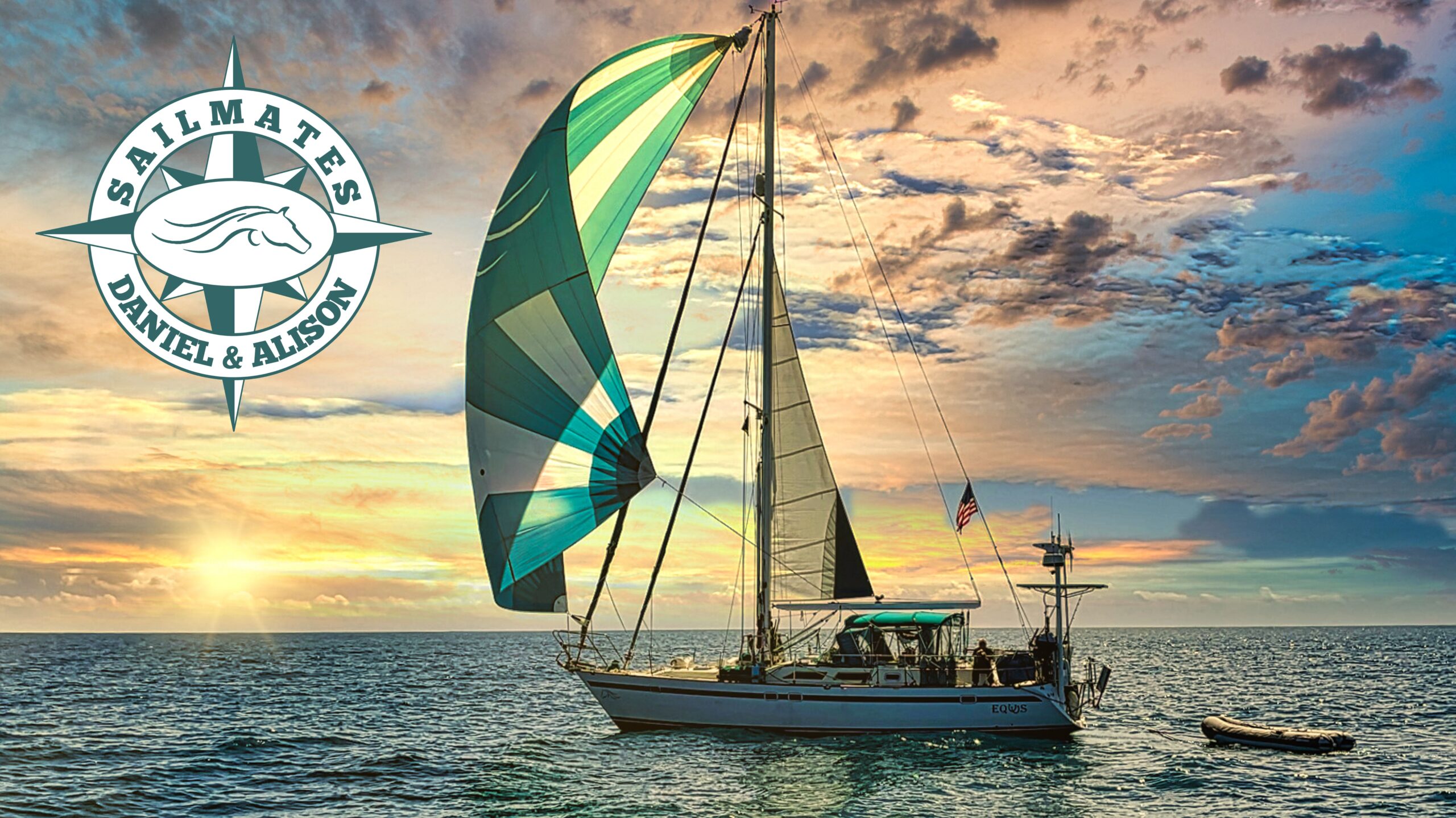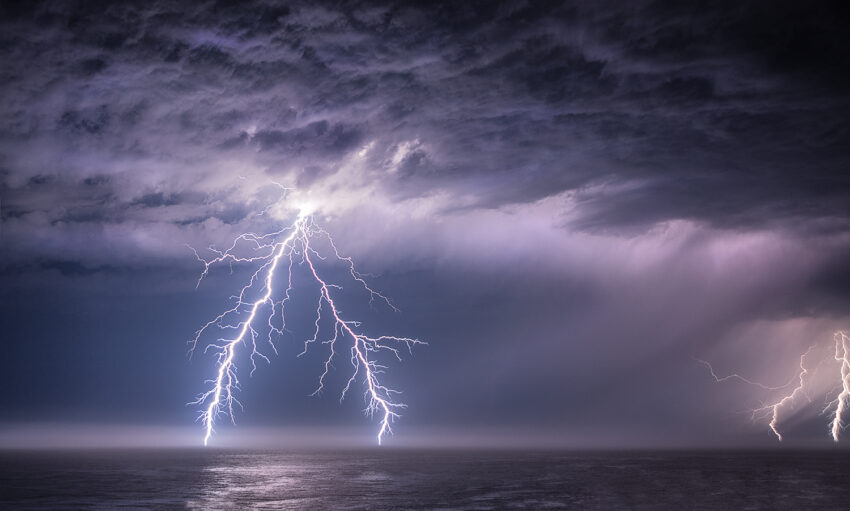Ready to Set Sail
Last week, we sent pictures of our departure and hopes of beginning our crossing of the Pacific Ocean to the magical islands of Gambier. Our boat friends, John and Shannon on S/V Carisma, who we had planned to cross with, arrived at Vista Mar Marina, where we had been since December doing boat repairs. As soon as their work was completed, we were ready to set off together.
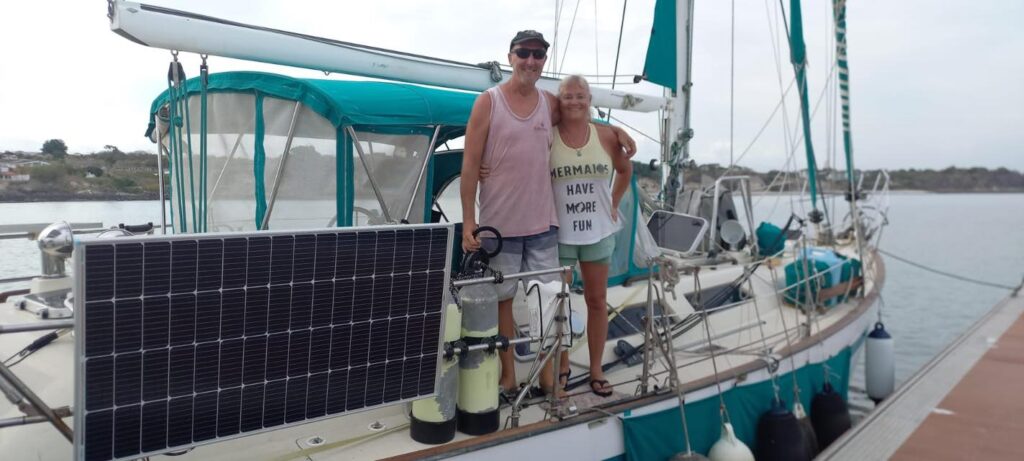
Everything seemed honky-dory: we were gassed up, provisioned, and high with anticipation of crossing the equator for the first time (you officially become a Shellback when you sail across the equator) and reaching French Polynesia, where many of our friends had already sailed and were waiting.
A Rough Start for Carisma
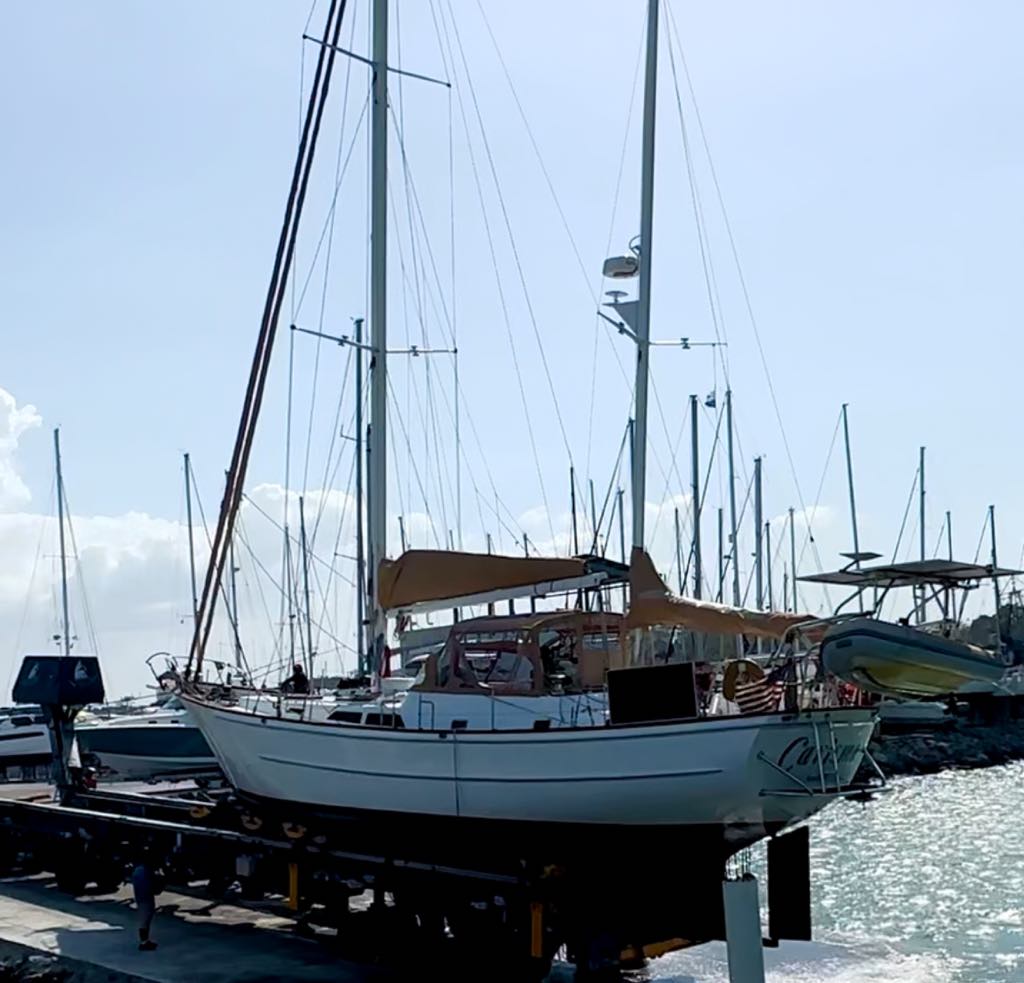
Carisma had a few issues as they were leaving the marina. Their boat had to be pulled out of the water. After very intense labor, they fixed a leak that could only be reached by taking off their 200-pound rudder — their boat is a big girl. During the haul-out process, their sonar unit was damaged, and the owner of the marina refused to compensate them or take responsibility.
As soon as they were splashed, they didn’t want to spend one more minute in the marina and took off to our meeting spot for the crossing, Venao Beach Harbor at the tip of Panama—a perfect launching point for a Pacific crossing.
Our Stormy Departure
Off they went, both of us knowing we would be just a day behind. The section off the Panama coast we needed to cross is notorious for strong currents, gusty winds, and lightning storms. John and Shannon were flanked by passing storms but had a relatively good sail and steady winds for the 94-mile overnight passage to Venao.
A day later, we set off. We were not quite as lucky.
Storms were not predicted, yet within the first few hours, we were squeezed by two lightning storms—one behind us and one in front of us. Dan couldn’t explain how these large storms were not predicted and were now looming around us.
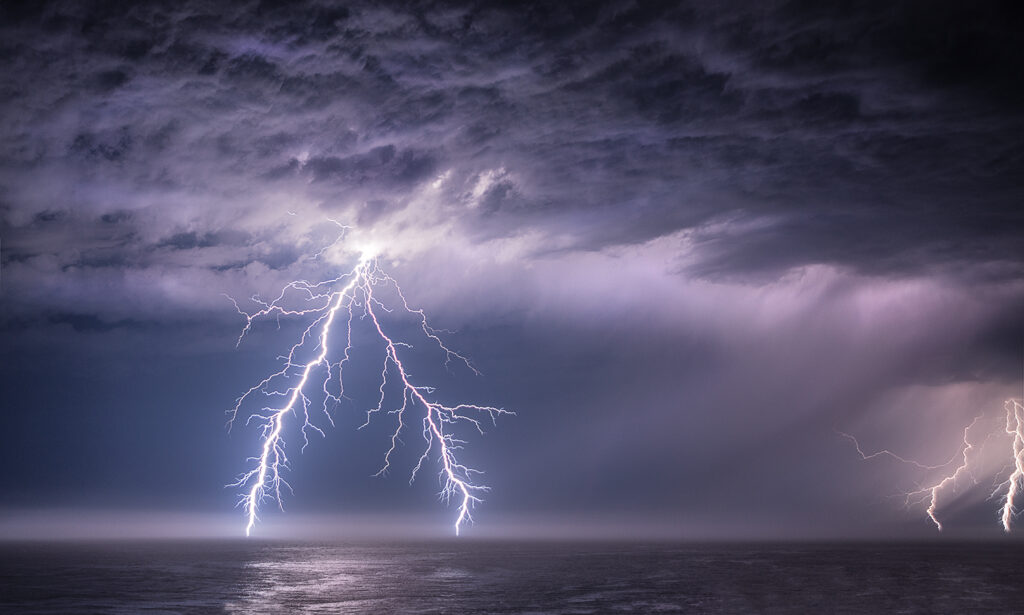
As the winds gusted into the high twenties and the lightning grew closer and more intense, I began to worry about a lightning strike. We know at least eight people whose boats have been hit by lightning and had all their electronics taken out. I did NOT want to be the next victim.
Taking what precautionary measures I could, I put our computers, tablet, and cell phones in the oven, which protects them like a Faraday cage. The rest of our electronics would be damaged, but at least we could call for help.
The sailing was intense. We had a reefed main and our staysail out. Our boat handled the storm well, maintaining a steady course through the choppy seas and erratic wind. After about two hours, the lightning began to decrease, the wind abated, and just like that, it died altogether.
Dan was astounded at how all our wind had been sucked away with the storms.
Fighting Currents and Unexpected Guests
The problem was, we faced drifting aimlessly—the current pushing us back the way we had come—or using the precious fuel we needed to cross the Pacific. Our boat buddies can store 400 gallons of fuel; we can store 90 gallons in our tanks and another 40 gallons in eight jerry cans on deck.
Drifting toward another brewing storm was a bad idea, so Dan bit the bullet and turned on the engine. I took the night watch as we motored through the still, inky ocean, lightning flickering on the distant horizon.
The first thing I noticed after Dan went to sleep was the sound of a cricket. I tried to think why there would be a cricket aboard, as we had never seen one during the five months we spent in the marina. Then I thought about the big bunch of green bananas we had stowed in a fruit and veggie net on our stern. I had heard of spiders hiding in bananas—but never crickets.
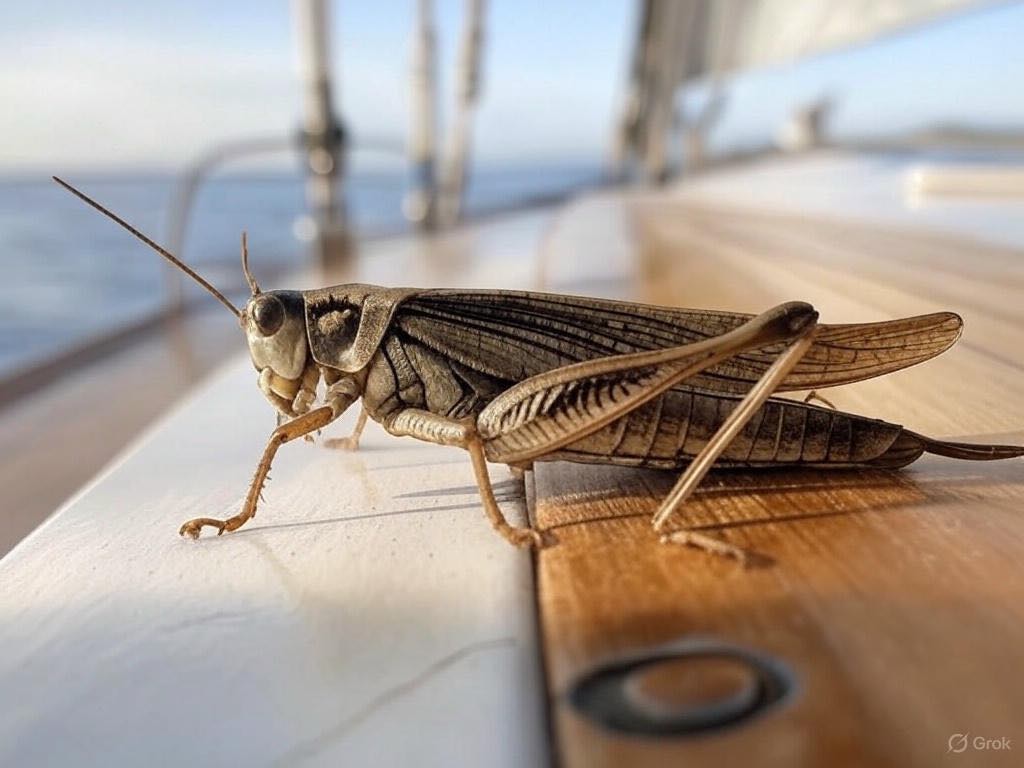
As I sat inside the main cabin, watching the radar screen and listening to the chirping, I found it soothing. Would it be so bad to have a cricket aboard?
Then, suddenly, in the darkness, a projectile hit my bare leg. I jolted and jumped. I made out the outline of a cricket on the floor next to my foot. Horrified, as I’m not a huge insect lover, I dove to trap the cricket in my hands. I was successful on my first attempt.
The insect wiggled inside my clenched fist, and it took all my willpower not to scream and release it — not until I got on deck. I sprinted up the stairs to the cockpit and launched the insect into the sea.
“See ya, fish food,” I said with a smug grin.
Satisfied that I had defeated the beast, I returned to the safety of the cabin. As soon as I sat down, I heard the sound of chirping again. It was soon joined by many other chirpers, and I had the horrible realization that we were infested with crickets.
How was this possible? These crickets were huge, and there was no way they had all come from the bananas—and we had been nowhere near shore.
Engine Failure and a Long Night
It was about 3:00 AM when our engine died. The sound of the steadily humming engine melting into silence hit us like a silent scream. The silence woke Dan immediately, and he rushed up onto the deck, spewing expletives.
We have had issues with our fuel lines clogging with algae. The fuel in warm climates is notorious for growing a strain of algae that works its way into your fuel lines, killing your engine. It happened several times on our way to Panama, but Dan had cleaned and rinsed our fuel tank, and we thought our issues were behind us. Apparently not.
Within 20 minutes, Dan had blown out the lines and got the engine started again. As we both knew, this was most likely a temporary fix. Another block could occur at any moment. There was nothing we could do but pray we arrived safely in the harbor, which was still several hours away.
Now that Dan was awake and back on deck, he heard the cacophony of cricket voices emanating from every corner.
“Where the hell did the crickets come from?” he asked, astounded.
We went through all the possible scenarios, and it turned out Dan had heard of crickets being swept up in storms and deposited on boats. It was rare, but it seemed we had fallen victim to this unusual weather phenomenon. (Frogs and schools of small fish have also been known to be carried by storms.)
Among those choices, I was happy to have crickets. Their chirping reminded me of being back on our farm.
Reaching Harbor and a Fuel Challenge
Dan refused to sleep and stayed awake until we entered the harbor the next morning. John and Shannon’s boat was the only other one there as we rounded into the harbor and found a spot to anchor. They greeted us and asked how our passage was.
We gave them the news: not only did we have a cricket infestation, but we used all eight of our jerry cans to replace the diesel we used to get there. We would not be able to begin our Pacific crossing with them without our spare fuel onboard.
I had managed about three hours of sleep the night before; Dan got one. By noon, he had crashed and desperately needed sleep.
John and Shannon came up with an idea to replenish our empty fuel cans. They offered to pick me up in their dinghy and land on the harbor’s beach. From there, it was about a half-mile walk to a gas station. We would have to make two trips.
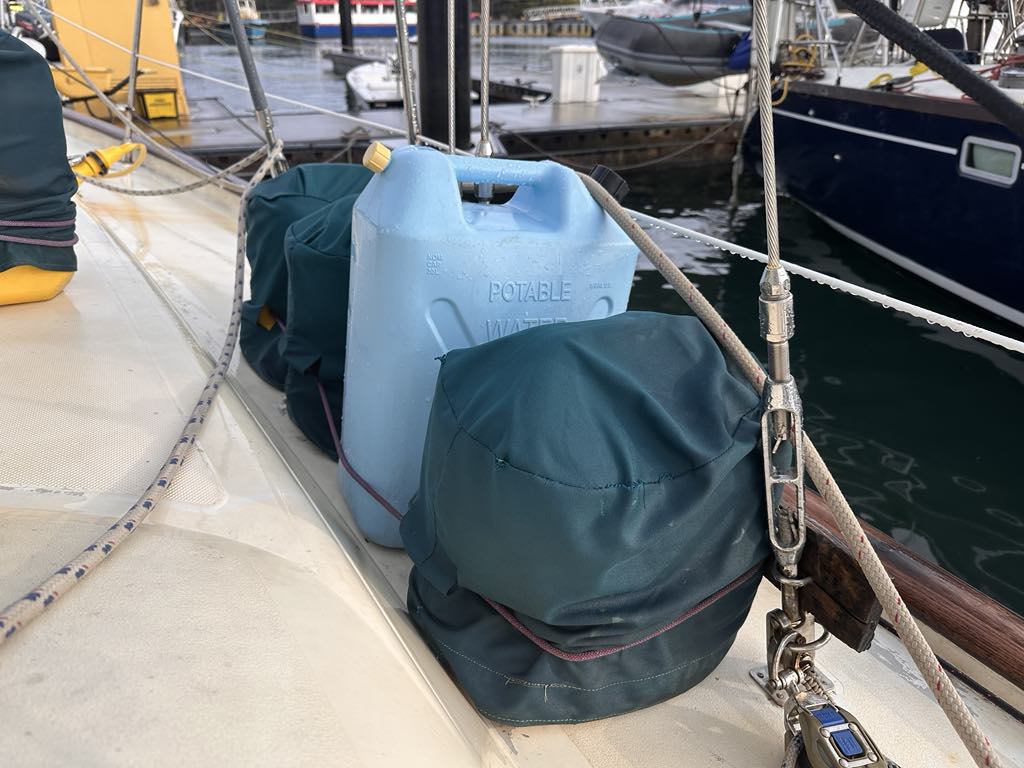
Landing the dinghy on shore was a wet adventure, as the surf on the beach was aggressive. We had to bail out of the dinghy between waves and drag it onto the sand—it weighs several hundred pounds. The walk to the station was easy, but carrying two full cans each (about 25 pounds per can) was horrible.
We could make it about 100 feet before our muscles burned and our hands slipped. We had to stop, rest, and start over. The paved road wasn’t too bad, but the ¼ mile stretch of beach back to the dinghy—walking in sand—was brutal.
After the first load, we had to repeat the process. John carried one can; Shannon and I each shared the handle of another. We still had to stop every 200 feet and switch hands. I knew I would be sore the next day—or thought I knew. I was wrong. It was much worse than expected; my rhomboids felt like they were on fire for two days.
Another Attempt to Cross
With full fuel cans and high hopes, Dan thought our engine would be okay. We were back on track to cross the Pacific with our friends. John researched the best weather window to depart, and it looked like we would be pulling up anchor at 4:00 AM.
Four o’clock arrived way too early for my aching rhomboids, but we pulled up anchor and headed off into a dark and moonless pre-dawn. We headed out of the harbor and set our sails, hoping to reach offshore winds. We were out in front of another storm system that would give us the push we needed.
As soon as we were clear of land, both boats hoisted their sails. Our engine was running, and Carisma was ahead of us. Dan motioned for me to look next to our boat.
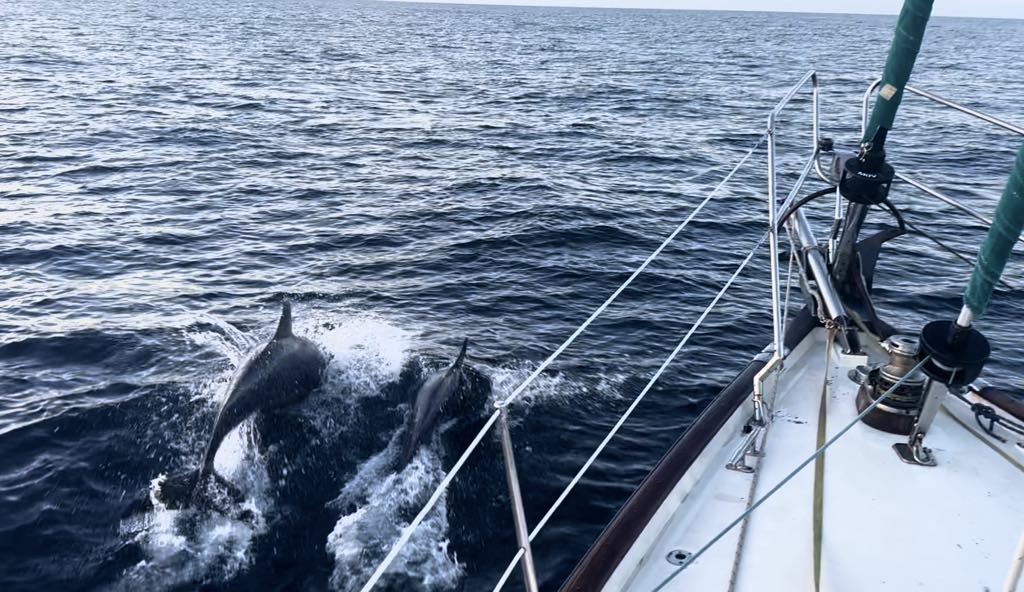
In the darkness, dolphins had appeared and were diving erratically around the boat. It didn’t seem like the normal, happy, playful behavior we usually see.
Five minutes later, it came again—the silent scream—the heartbreaking sound of the engine dying.
Making the Toughest Decision
We drifted. Carisma began to pull away.
“What should we do?” Dan asked quietly. “I can probably get the engine started again… but do we want to cross an ocean knowing we have this problem? What if this happens when we really need our engine?”
“You’re the captain. You decide,” I told him. I secretly hoped he would choose to fix the issue before we crossed.
“I think the right thing to do would be to turn around,” he uttered, clearly distraught and disappointed.
With that, we turned the boat back in the direction we had come from. The moment we turned, the wind filled in and carried us swiftly. Light was beginning to filter over the horizon, and a school of dolphins arrived again, seeming to acknowledge our decision. They played joyfully in our bow wake.
Dan hopped on the radio and informed Carisma of our decision. They were saddened but understood completely. Our boats parted ways—Carisma sailed toward Gambier, and we sailed back into familiar waters with an unknown destination.
Facing a Miserable Return
We didn’t want to go back to Vista Mar. We aimed to reach Panama City, where there would be more options for repairs—a two-day sail.
In the first few hours, the wind was excellent. But by later in the day, the clouds moved in, and the wind started blowing against us. It was rough enough that I became nauseous. I couldn’t eat lunch. We had to start the engine.
The waves built up and the boat slammed into them. Our speed was slow. The ride? Miserable.
By dark, the wind was howling, straight into us. The waves were viscous, heavy with force. Water started pouring through our forward hatches — we hadn’t dogged them down tightly enough. Our forward berth was soaked with saltwater. Everything in the cockpit was drenched. It was too rough to even think about dinner.
By midnight, we were exhausted. Conditions hadn’t improved. Dan made his second executive decision of the day: the closest port was Vista Mar — exactly where we didn’t want to be. But the track to get there would take us away from the pounding wind and into calmer water along the shore. We tacked out our staysail and headed for land.
A Near Miss in the Dark
Around 3:00 AM, we were sailing into the harbor at Vista Mar. White lights dotted the ocean, now fairly calm with just a light breeze. We were flying in under motor. The lights turned out to be small fishing boats. Dan told me to watch the right side; he watched the left. We only had about 30 minutes to go before reaching the marina entrance where we could anchor.
Suddenly, I screamed. Dead ahead, the lights of a fishing boat flared to life — the captain must have realized we were bearing down on him. We were doing 6.5 knots, and the autopilot was on. Dan raced to the helm, but there wasn’t enough time to change course. With just feet to spare, we sped past the tiny craft. Had we collided, it would have been disastrous for both boats. Adrenaline pumping, we took a huge breath of relief, and Dan quickly throttled back. The next 30 minutes, we never took our eyes off the water.
A Change of Course

The rest of the story is simple: we anchored safely at the marina — the same place I thought we had said goodbye to just two days before. Early the next morning, we pulled out and motored five hours to a beautiful little island between Vista Mar and Panama City. We spent the night alone in the harbor, relaxed and thankful to be alive, in love, and afloat — the only things that really matter.
We are now safely tied up in La Playita Marina. A fuel polishing specialist is scheduled to strain our fuel, clean the tanks, and treat them with algacide to prevent more clogged fuel lines. We also have an appointment Monday with an engine expert to fine-tune and replace some aging parts. We need her running perfectly for our upcoming crossing.
Meanwhile, Carisma, had her own eventful beginning. Just two days ago, they received a distress call from a sailboat named Moana — their engine was in trouble, and they needed 16 liters of oil. Carisma made a daring transfer of oil in rough seas to help them. Unfortunately, that leak they thought was fixed in Vista Mar has returned, and now they’re struggling with repairs at sea.
As you can see, smooth sailing is rare. If it happens, it’s a blessing. Most cruisers we know who have already crossed have suffered some form of breakage. We are praying that all our bad luck is behind us, and when we finally leave in a few days, our crossing will go smoothly. Maybe our penance has already been paid.
Lessons from the Sea
This wasn’t the start to our next adventure that we had hoped for. I’ve now said goodbye to Panama City three times — only to be pulled back. It’s a horrible, sinking feeling. When we finally do leave, I won’t make the mistake of waving goodbye and saying, “I’ll never see you again.” Clearly, that’s bad luck.
One thing I know for sure: we are always exactly where we are meant to be, exactly when we are meant to be there. It’s a lesson life at sea teaches over and over again — and I trust it, completely.
Stay tuned. We will get out to sea and cross the Pacific to the Gambier Islands. What happens along the way? That remains to be seen!
Stay Tuned!
We will be reporting as we finally head out. Our route has changed since we parted ways with Carisma. Our friend Rob Dehan, a circumnavigator and weather router has advised us to head down the coast toward Equadore. If we need to motor we can do so as we will be fighting current. We can refuel in Equador before crossing toward the Galapagos having a better angle to cross the wind instead of heading into it.
I will post pictures out at sea and relay how the trip is going. You can track us on our Sailmates Home Page by clicking on Equus Tracker. Thank you for joining us on this journey. We are keeping the faith and hope to have amazingly good stories to tell and beautiful photos of the French Polynesians to share with you.
Fair Winds,
Captain Dan and First Mate Alison
S/V Equus

